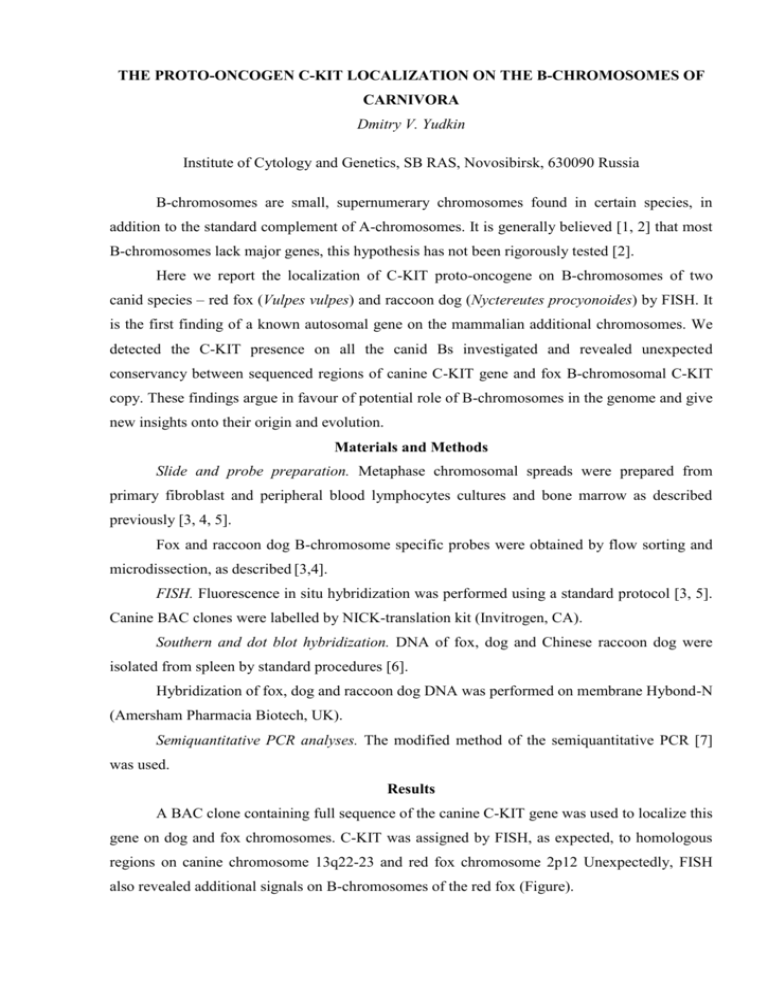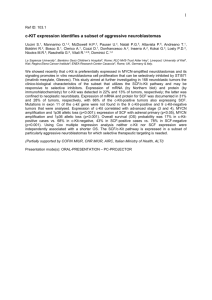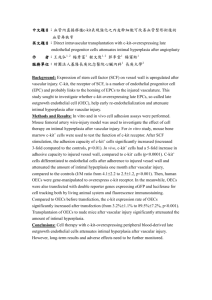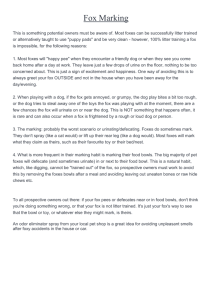The proto-oncogen C-KIT localization on the B
advertisement

THE PROTO-ONCOGEN C-KIT LOCALIZATION ON THE B-CHROMOSOMES OF CARNIVORA Dmitry V. Yudkin Institute of Cytology and Genetics, SB RAS, Novosibirsk, 630090 Russia B-chromosomes are small, supernumerary chromosomes found in certain species, in addition to the standard complement of A-chromosomes. It is generally believed [1, 2] that most B-chromosomes lack major genes, this hypothesis has not been rigorously tested [2]. Here we report the localization of C-KIT proto-oncogene on B-chromosomes of two canid species – red fox (Vulpes vulpes) and raccoon dog (Nyctereutes procyonoides) by FISH. It is the first finding of a known autosomal gene on the mammalian additional chromosomes. We detected the C-KIT presence on all the canid Bs investigated and revealed unexpected conservancy between sequenced regions of canine C-KIT gene and fox B-chromosomal C-KIT copy. These findings argue in favour of potential role of B-chromosomes in the genome and give new insights onto their origin and evolution. Materials and Methods Slide and probe preparation. Metaphase chromosomal spreads were prepared from primary fibroblast and peripheral blood lymphocytes cultures and bone marrow as described previously [3, 4, 5]. Fox and raccoon dog B-chromosome specific probes were obtained by flow sorting and microdissection, as described [3,4]. FISH. Fluorescence in situ hybridization was performed using a standard protocol [3, 5]. Canine BAC clones were labelled by NICK-translation kit (Invitrogen, CA). Southern and dot blot hybridization. DNA of fox, dog and Chinese raccoon dog were isolated from spleen by standard procedures [6]. Hybridization of fox, dog and raccoon dog DNA was performed on membrane Hybond-N (Amersham Pharmacia Biotech, UK). Semiquantitative PCR analyses. The modified method of the semiquantitative PCR [7] was used. Results A BAC clone containing full sequence of the canine C-KIT gene was used to localize this gene on dog and fox chromosomes. C-KIT was assigned by FISH, as expected, to homologous regions on canine chromosome 13q22-23 and red fox chromosome 2p12 Unexpectedly, FISH also revealed additional signals on B-chromosomes of the red fox (Figure). To investigate C-KIT localization in genomes of other canids with and without Bs we hybridized the C-KIT probe onto chromosomes of Chinese raccoon dog, Japanese raccoon dog and arctic fox (another canid species that lacks Bs). The hybridization results demonstrate that the C-KIT probe was localized to the proximal part of the long arm of Chinese raccoon dog chromosome 6, the proximal part of Japanese raccoon dog chromosome 2q and arctic fox chromosome 11p13. In both Chinese and Japanese raccoon dog signals Figure Localization of C-KIT probe onto G-banded chromosomes of red fox. were also revealed on the distal part of all Bs. The presence of autosomal genes on the B-chromosomes would favour the theory of an autosomal origin of additional elements. If B-chromosomes bearing C-KIT originated from a large autosomal segment, they might contain some other genes near to the C-KIT sequences. We localized C-KIT neighbouring genes on fox chromosomes and not detect it on Bs. Ten C-KIT exons from the fox B-chromosome library (4, 5, 6, 7, 8, 11, 12, 17, 18, 21) were sequenced and the exon-intron boundaries were observed as was expected. To estimate the correlation of B-chromosomes and C-KIT copy number we performed Southern and dot hybridization with dog, fox, and raccoon dog genomic DNA, and semiquantitative PCR. The positive correlation between C-KIT copy number and the number of Bs was observed. Conclusion If the B-chromosomes of the raccoon dog and fox have originated from the karyotype of a putative common ancestor, they have become lost in all other extant 25 Canidae species lacking Bs. In the 12.5 MYA since the fox and raccoon dog first diverged, their karyotypes have become highly rearranged. In this situation, one would expect the supernumerary chromosomes usually degenerate via the mechanism of Muller’s Ratchet [8], and the C-KIT sequences would not have been conserved for such a long time. However, comparison of fox C-KIT exons amplified from B-chromosome library and canine C-KIT sequence revealed very little variation. If the presence of the C-KIT gene on B-chromosome is not beneficial for the host cell we would expect an accumulation of multiple mutations in its coding region. So far the sequence data has failed to confirm it.Further experiments should show if B-chromosomal and autosomal copies are identical, if B-chromosomal C-KIT genes are expressed, and if C-KIT genes are present in other mammalian B-chromosomes. It can be concluded, however, that the detection of the same gene on the Bs of two different species argues against a current view that B-chromosomes represent parasitic elements of certain genomes. This study was funded in part by the MCB, RFBR, DGPAH, EOB research grants (A.S.G), INTAS Grant to A.S.G and M.A.F.-S References 1. JONES RN, REES H (1982) B chromosomes. London: Academic Press. 2. CAMACHO JPM, SHARBEL TF, BEUKEBOOM LW (2000) B-chromosome evolution. Phil Trans R Soc Lond B 355: 163–178. 3. YANG F, O'BRIEN PC, MILNE BS et al. (1999) A complete comparative chromosome map for the dog, red fox, and human and its integration with canine genetic maps. Genomics 62: 189-202. 4. TRIFONOV VA, PERELMAN PL, KAWADA SI, IWASA MA, ODA SI, GRAPHODATSKY AS (2002) Complex structure of B-chromosomes in two mammalian species: Apodemus peninsulae (Rodentia) and Nyctereutes procyonoides (Carnivora). Chromosome Res 10: 109-116. 5. GRAPHODATSKY AS, YANG F, O'BRIEN PC, SERDUKOVA N, MILNE BS et al. (2000) A comparative chromosome map of the Arctic fox, red fox and dog defined by chromosome painting and high resolution G-banding. Chromosome Res 8: 253–263. 6. SAMBROOK J, FRITSCH EF, MANIATIS T (1989) Molecular Cloning: A Laboratory Manual. New York: Cold Spring Harbor Laboratory Press. 7. MARONE M, MOZZETTI S, DE RITIS D, PIERELLI L, SCAMBIA G (2001) Semiquantitative RT-PCR analysis to assess the expression levels of multiple transcripts from the same sample. Biol Proced Online 16: 19-25. 8. GREEN DM (1990) Muller's Ratchet and the evolution of supernumerary chromosomes. Genome 33: 818-824.









